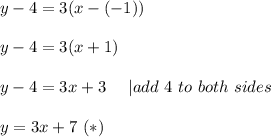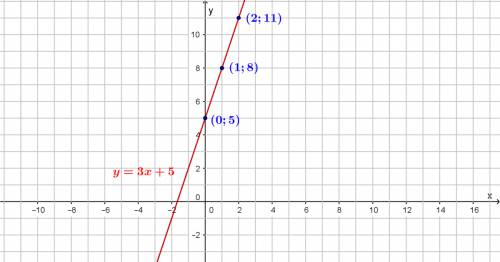 45
45 There is exactly one output for each input.
The graph of a linear function is a straight line.
A linear function has a constant rate of change.
Step-by-step explanation:
 14
14 1. The correct answer is letter (C) There is no solution since 4 = 5 is a false statement.
2. The equation that has solution is:
6x - (3x
+ 8) = 16x
6x - 3x - 8 = 16x
3x - 8 = 16x
-13x = 8
x = -8/13
3. The coordinate grids above shows equations y = 3x - 2 and 2x - y = 4. The correct answer is graph letter (A)
4. Select ALL of the functions.
The functions are letter (A) and letter (D).
5. Write the difference in the rates of change for these two functions
The equation in the table is
m = (Y1-Y2) / (X1-X2)
m = (4-12) / (0-2)
m = -8 / -2
m = 4
y = mx+b
4 = 4(0) + b
b = -4
So the equation of the table is y = 4x - 4.
The second equation is y = 7x + 4.
(0 , 4)
(2 , 18)
(4 , 32)
(6 , 46)
The difference rate is (0, 6, 12, 18) is 6n.
6. The function is linear.
7. The function is nonlinear.
8. The function is linear.
9. The function is nonlinear.
10. The correct answer is letter (C).
11. The correct answer is letter D. Linear function with positive slope
 14
14 1. The correct answer is letter (C) There is no solution since 4 = 5 is a false statement.
2. The equation that has solution is:
6x - (3x
+ 8) = 16x
6x - 3x - 8 = 16x
3x - 8 = 16x
-13x = 8
x = -8/13
3. The coordinate grids above shows equations y = 3x - 2 and 2x - y = 4. The correct answer is graph letter (A)
4. Select ALL of the functions.
The functions are letter (A) and letter (D).
5. Write the difference in the rates of change for these two functions
The equation in the table is
m = (Y1-Y2) / (X1-X2)
m = (4-12) / (0-2)
m = -8 / -2
m = 4
y = mx+b
4 = 4(0) + b
b = -4
So the equation of the table is y = 4x - 4.
The second equation is y = 7x + 4.
(0 , 4)
(2 , 18)
(4 , 32)
(6 , 46)
The difference rate is (0, 6, 12, 18) is 6n.
6. The function is linear.
7. The function is nonlinear.
8. The function is linear.
9. The function is nonlinear.
10. The correct answer is letter (C).
11. The correct answer is letter D. Linear function with positive slope
 47
47 Answer
a) linear
Explanation
There is a simple way to tell if a function is linear from a table: look at the x and y-values; if the y-values are increasing or decreasing by the same amount when their corresponding x-values increases or decreases by the same amount, you have a linear function; otherwise, you don't.
Look at the table
From 0 to 1 x is increasing by 1; from 8 to 10 (the corresponding values), y is increasing by 2
From 1 to 2 x is increasing by 1; from 10 to 12, y is increasing by 2
So, every time that x increases by 1, y increases by 2; therefore, we have a linear function.
Notice that form -2 to 0 x is increasing by 2; from 4 to 8 increasing by 4, which is the same rate as before (when x increases 1, y increases 1)
2)Answer
xy
03
15
27
39
Explanation
When x increases by 1, y increases by 2; therefore we have a linear function.
If you look at the first and third tables, y increases at different amounts every time x increases by 1; therefore, they are not linear functions.
In the first table when x increases by 1, y increases by 2, 4, or 10. Therefore, the table is not a linear function.
Similarly, in the third table when x increases by 1, y increases by 1, 3, or 5. Therefore, the table is not a linear function.
3)Answer
a) nonlinear
Explanation
A linear function is function of the form:  or
or  where
where  is the independent variable and
is the independent variable and  is the dependent variable.
is the dependent variable.
In a linear function the coefficient of the variables is always 1.
Notice that the coefficient of the independent variable  , in the function
, in the function  , is 2; therefore the function is nonlinear.
, is 2; therefore the function is nonlinear.
Answer
2=x3+y Nonlinear
y+1=5(x−9) Linear
7y + 2x = 12 Linear
4y = 24 Linear
Explanation
2=x3+y The coefficient of the independent variable, x, is 3; therefore, the function is not linear.
y+1=5(x−9) We can simplify the expression to get:
y+1=5x-45
y=5x-46
Since y=5x-46 is in the form y=mx+b, we have a linear function.
7y + 2x = 12
Since 7y + 2x = 12 is a function of the form Ay + Bx = C, it is a linear function
4y = 24 We can siplify to get:


Since y=6 is a function of the form y = mx+b (with m=0), it is a linear function.
5)Answer
b) is not
Explanation
From 22 to 20, x decreases by 2; from 26 to 22, y decreases by 4. So, when x decreases by 2, y decreases by 4.
From 16 to 14, x decreases by 2; from 20 to 18, y decreases by 2. So, when x decreases by 2, y decreases by 2.
When x decreases by 2, y decreases by 4 or 2; therefore the function represented in the table is not a linear function.
 47
47 Answer
a) linear
Explanation
There is a simple way to tell if a function is linear from a table: look at the x and y-values; if the y-values are increasing or decreasing by the same amount when their corresponding x-values increases or decreases by the same amount, you have a linear function; otherwise, you don't.
Look at the table
From 0 to 1 x is increasing by 1; from 8 to 10 (the corresponding values), y is increasing by 2
From 1 to 2 x is increasing by 1; from 10 to 12, y is increasing by 2
So, every time that x increases by 1, y increases by 2; therefore, we have a linear function.
Notice that form -2 to 0 x is increasing by 2; from 4 to 8 increasing by 4, which is the same rate as before (when x increases 1, y increases 1)
2)Answer
xy
03
15
27
39
Explanation
When x increases by 1, y increases by 2; therefore we have a linear function.
If you look at the first and third tables, y increases at different amounts every time x increases by 1; therefore, they are not linear functions.
In the first table when x increases by 1, y increases by 2, 4, or 10. Therefore, the table is not a linear function.
Similarly, in the third table when x increases by 1, y increases by 1, 3, or 5. Therefore, the table is not a linear function.
3)Answer
a) nonlinear
Explanation
A linear function is function of the form:  or
or  where
where  is the independent variable and
is the independent variable and  is the dependent variable.
is the dependent variable.
In a linear function the coefficient of the variables is always 1.
Notice that the coefficient of the independent variable  , in the function
, in the function  , is 2; therefore the function is nonlinear.
, is 2; therefore the function is nonlinear.
Answer
2=x3+y Nonlinear
y+1=5(x−9) Linear
7y + 2x = 12 Linear
4y = 24 Linear
Explanation
2=x3+y The coefficient of the independent variable, x, is 3; therefore, the function is not linear.
y+1=5(x−9) We can simplify the expression to get:
y+1=5x-45
y=5x-46
Since y=5x-46 is in the form y=mx+b, we have a linear function.
7y + 2x = 12
Since 7y + 2x = 12 is a function of the form Ay + Bx = C, it is a linear function
4y = 24 We can siplify to get:


Since y=6 is a function of the form y = mx+b (with m=0), it is a linear function.
5)Answer
b) is not
Explanation
From 22 to 20, x decreases by 2; from 26 to 22, y decreases by 4. So, when x decreases by 2, y decreases by 4.
From 16 to 14, x decreases by 2; from 20 to 18, y decreases by 2. So, when x decreases by 2, y decreases by 2.
When x decreases by 2, y decreases by 4 or 2; therefore the function represented in the table is not a linear function.
 4
4 Function A is non-linear and Function B is linear.
Step-by-step explanation:
Linear function:
Has the following format:
y = mx + b
In which m is the slope and b is the y-intercept.
In a linear function, when x changes by 1, y will always changes by the same amount.
Function A:
When x changes by 1, y can change by various amounts. So function A is non-linear.
Function B:
y = -x + 5
In the format of a linear function, so linear
 5
5  4
4 Function A is non-linear and Function B is linear.
Step-by-step explanation:
Linear function:
Has the following format:
y = mx + b
In which m is the slope and b is the y-intercept.
In a linear function, when x changes by 1, y will always changes by the same amount.
Function A:
When x changes by 1, y can change by various amounts. So function A is non-linear.
Function B:
y = -x + 5
In the format of a linear function, so linear
 5
5  78
78 











It will provide an instant answer!
